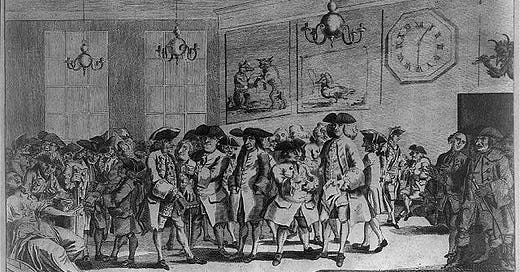The Ottoman Empire is the first to build what would come to be known as coffeehouses. Initially financed by Jewish merchants, the popularity of these establishments led to the creation of coffeehouses in the major cities across the empire such as Damascus, Mecca, and Istanbul during the 15th century. Made to serve coffee (newly imported from Ethiopia) and serve small meals/snacks. Popular for being a meeting place for wealthy patrons to enjoy music, discuss news, or play chess. These so called “schools of wisdom” had many in power concerned with this growing collection of community dialogue. Religious figures enacted bans from these shops due to fears of anti-religious activity, but the popularity made the ban temporary. Soon though these coffeehouses began to spread across the Mediterranean to areas like Venice, Livorno, and Genoa.
By 1650, the first English coffeehouse was open in Oxford, just like their Ottoman counterpart these began as cultural meeting centers for intellectuals. Yet as they became more common, a new type of crowd began to form. Members of the middle and lower classes began to stop by for conversation either after a long day at work or after a long night at the pub. In 1739, London by itself had over 550 coffeehouses, all of which followed the same principle of allowing all members of society to be a customer. Englishmen being able to conversate with each other about the now growing Empire of Great Britian stimulated a new type of business practice took place. This practice is known as stock market trading, so common that Jonathan's Coffee House in 1698 saw the listing of stock and commodity prices that it evolved into the London Stock Exchange. Many new trade companies are created for these stock market brokers to sell shares of these new imperial investments. Auctions in salesrooms attached to coffeehouses provided the start for the great auction houses of Sotheby's and Christie's. This was especially lucrative for the growing middle class of Englishmen who used this environment to hold financial meetings with each other about the economic news of the day.
Along with financial information, new ideas of republicanism gained traction in the various coffeehouses due to a growing anti-absolutist sentiment. Pamphlets and books criticizing the government and royal family grew in popularity as a result. Again, the various kings would try to end these political conversations by banning these establishments but again none of these coffeehouses remained close. So accepted were coffeehouses that rival politicians like the Toris and the Whigs would frequent the same establishments, giving each other more respect than they had on the floor of parliament. This tradition of political conversation even followed the British to the 13 colonies, patriots in revolt against the king went to coffeehouses to avoid consuming tea. While there, colonists began espousing anti-monarchial beliefs, some of which would go on to become the Founding Fathers of The United States. Whether they were drinking coffee or tea, coffeehouses served a similar purpose to that which they did in Great Britain, as places where business was done. In the 1780s, Merchant's Coffee House located on Wall Street in New York City was home to the organization of the Bank of New York and the New York Chamber of Commerce.
Following the end of the 2nd World War, a new wave of Italian immigrants took the espresso bar model famous in the Italian metropolitan scene to the streets of Little Italy, Greenwich Village, Boston’s North End, and San Franciso’s North Beach. During the 1950s and 1960s these new coffeehouses became venues of entertainment, musicians like Joan Baez and Bob Dylan started their careers at open mics. Counterculture and Civil Rights movements of the 1960s/70s also used these businesses to plan protests or hold group meetings. The anti-war sentiment following the United States’ involvement in Vietnam used these coffeehouses as safe havens of political discourse, much like the founding fathers 200 years before. In the early 1990s, the popularity of these coffeehouse hangout spots saw Seattle entrepreneur Howard Schultz transform his small independently owned shops into a chain of the most well-known coffee brand across the world, Starbucks. People today view ordering at a coffeehouse as a luxury, no longer an epicenter of economic and political discussion. Ready-made coffee machines like the Keurig or Nespresso machines gives people a quality experience with the convivence of staying home. We will have to see what the future holds for the humble coffeehouses.






